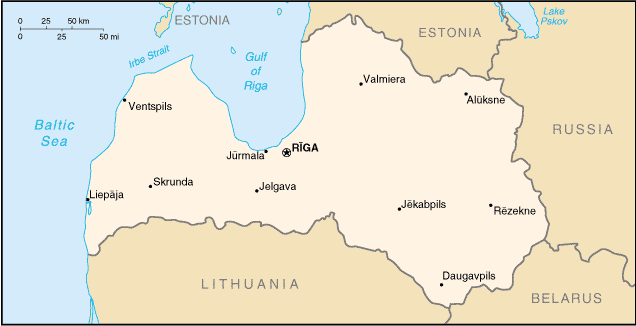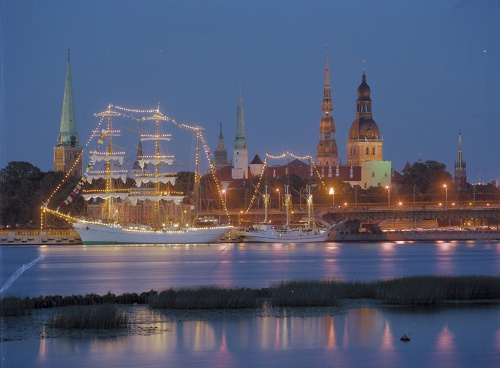|
RIGA
(REE-guh)
Capital
and largest city of Latvia
Common
clues: Latvia's capital; Baltic capital; Latvian seaport;
Baryshnikov birthplace; Capital where Lettish is spoken; Big
Baltic city; Letts live here
Crossword
puzzle frequency:
5 times a year
Video:
One
day in Riga
Let the devil into
church and he will climb into the pulpit ~ Latvian
Proverb
Riga
(Rīga
in Latvian), the capital of Latvia, is situated on the Baltic Sea
coast on the mouth of River Daugava, at 56°58′ N
24°8′ E. Riga is the largest city in the Baltic
States and serves as a major cultural, educational, political,
financial, commercial and industrial center in the Baltics.

Riga
is located at the site of an ancient settlement of the Livs, an
ancient Finno-Ugric tribe, at the junction of the Daugava and
Ridzene (Latvian: Rīdzene)
rivers. The Ridzene was originally known as the Riga River, at
one point forming a natural harbor called the Riga Lake, neither
of which exist today. Some believe that the name of the river
gave Riga its name.

The
1900's brought World War I and the impact of the Russian
Revolution to Riga. The German army marched into Riga in 1917. In
1918 the Treaty of Brest-Litovsk was signed giving the Baltic
countries to Germany. Because of the Armistice with Germany
(Compiègne) of November 11, 1918, Germany had to renounce
that treaty, as did Russia, leaving Latvia and the other Baltic
States in a position to claim independence.
After
more than 700 years of foreign occupation, Latvia, with Riga as
its capital city, thus declared its independence on November 18,
1918.
During
World War I and World War II (1918-1940), Riga and Latvia shifted
their focus from Russia to the countries of Western Europe. A
democratic, parliamentary system of government with a President
was instituted. Latvian was recognized as the official language
of Latvia. Latvia was admitted to the League of Nations. Driven
by the economics of comparative advantage, the United Kingdom and
Germany replaced Russia as Latvia's major trade partners. As a
sign of the times, Latvia's first Prime Minister, Karlis Ulmanis
(Latvian Kārlis),
had studied agriculture and worked as a lecturer at the
University of Nebraska in the United States of America.
Riga
was described at this time as a vibrant, grand and imposing city
and earned the title of "Paris of the North" from its
visitors.
This
period of rebirth was short-lived, however, as World War II soon
followed with Soviet occupation of Latvia in 1940, German
occupation in 1941-1944 and Soviet occupation of Latvia again at
the end of the war. The Baltic Germans were forcibly repatriated
to Germany after 700 years in Riga. Hundreds of thousands of
Latvians perished and thousands fled into exile in countries all
over the world. Latvia lost one-third of its population.
Soviet
occupation after the war was marked by deportations to Siberia
and elsewhere, forced industrialization and planned large-scale
immigration of large numbers of non-Latvians from other Soviet
republics into Riga, particularly Russians. By 1975 less than 40%
of Riga's inhabitants were Latvians, a percentage which has risen
since Latvian independence.
The
policy of economic reform introduced as Perestroika by Soviet
leader Mikhail Gorbachev led to a situation in the late 1980's in
which many Soviet republics, including Latvia, were able to
regain their liberty and freedom. Latvia declared its full de
facto
independence on August 21, 1991 and that independence was
recognized by Russia on September 6, 1991. Latvia formally joined
the United Nations as an independent country on September 17,
1991. All Russian military forces were removed from 1992 to 1994.
In
2001, Riga celebrated its 800th anniversary as a city. On March
29, 2004 Latvia joined NATO. On May 1, 2004 Latvia joined the
European Union.
This
article is licensed under the GNU
Free Documentation License.
It uses material from the Wikipedia
article "Riga".
AR
|